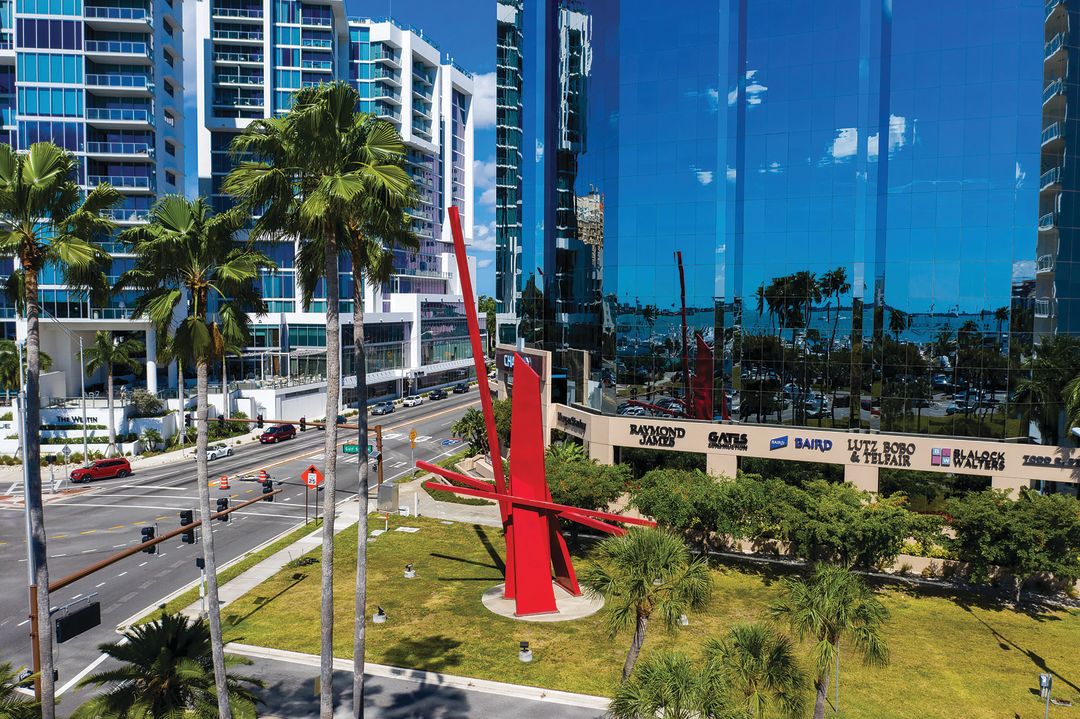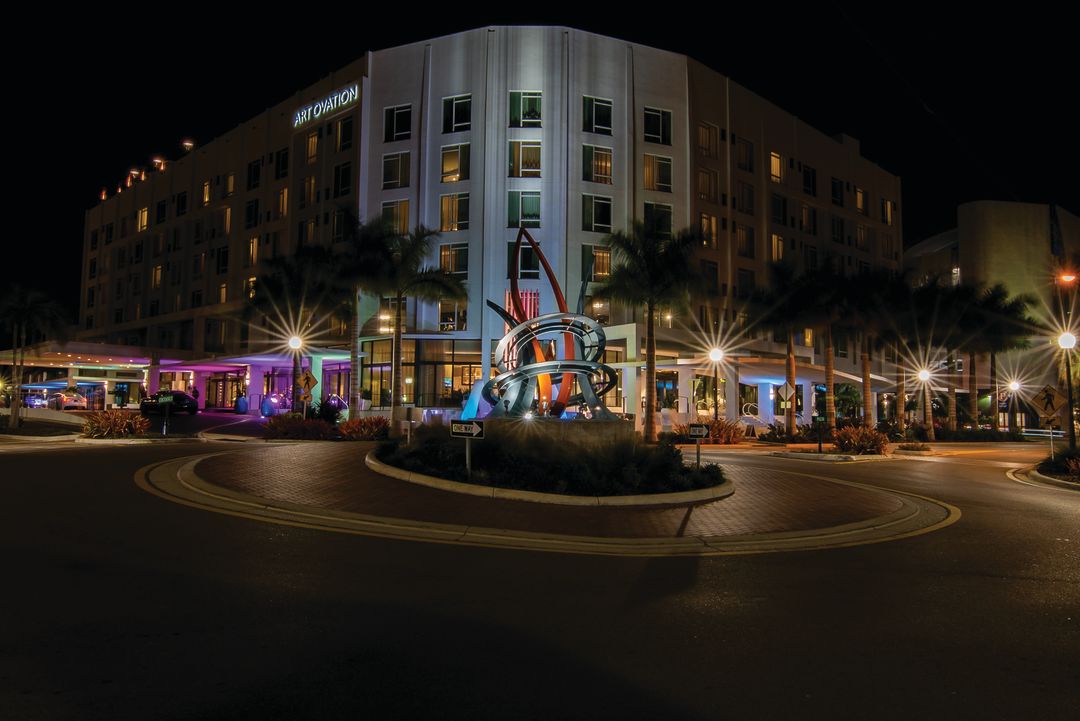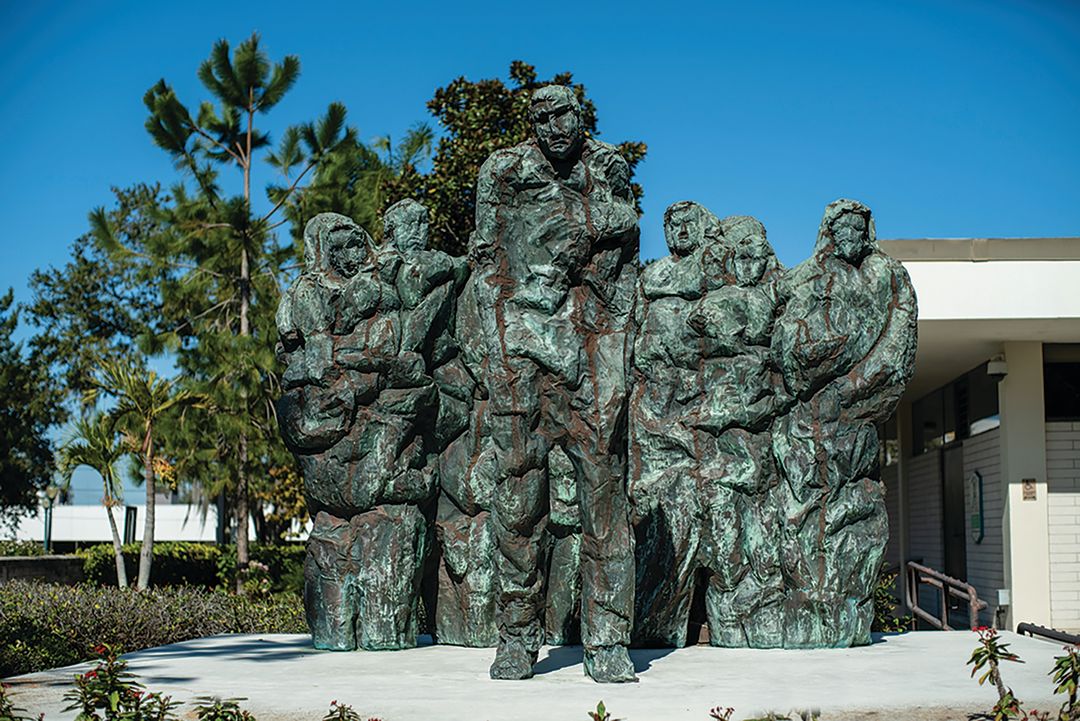
Sarasota's Collection of Public Art Features More Than 95 Works Citywide
When you’re trying to meet up with friends, numbered addresses and street names can’t compete with local landmarks.
Let’s meet by the red metal horse or the shell fountain. Even without a map, somehow you know where to be. Public art isn’t just eye candy, it’s an anchor.
Sometimes, it’s also a controversy. Like the 25-foot-tall Unconditional Surrender statue by Seward Johnson, based on the famous photo of a U.S. Navy sailor kissing a stranger on V-J Day in Times Square in 1945. Some see it as a joyous nod to the end of World War II, while others see it as a symbol of sexual harassment. On the Sarasota bayfront, it continues to attract thousands of couples each year who, below it, mimic its kissing pose for a pic in paradise.
Public art is also a status symbol. Although, in the past, it wasn’t called “public art,” outdoor décor has been a major part of Sarasota’s appeal ever since real estate developer and circus magnate John Ringling began dressing up boulevards with classical bronze and limestone figures in the 1920s.
No matter how it’s defined, in 1986, the City of Sarasota put a ring on it and made our relationship with public art official when it established the Public Art Committee (PAC). Commissioners were keen to enhance the town’s reputation as an arts city by acquiring works of art for prominent downtown locations. After all, there was a legacy to uphold. During the 1950s and ’60s, a starry group of painters, musicians, architects and writers lived and worked in this flourishing artists’ community. The city purchased several works after the committee formed, including Jack Cartlidge’s large-scale hammered copper sculpture, Nobody’s Listening, for the plaza outside then-new Sarasota City Hall in 1967.
More recently, the city acquired Complexus, a geometric, bright red, steel abstract piece by John Henry. (The sculpture previously stood near the base of the John Ringling Causeway, but, because of construction, is temporarily on loan to the Sarasota Art Museum.) The piece was so beloved that downtown residents and art aficionados rallied to raise the $550,000 to purchase it in just a year’s time. It became part of the city’s public art collection in 2013.
Today, the Office of Public Art has a collection of more than 95 works citywide that has grown beyond sculptures and statues. Murals climb up and across the new walls that bind some downtown streets, adding flair and movement to an otherwise static, high-rise condo-sphere, as with Flora Urbana by artist Danny Doya, the developer’s public art contribution for The Mark condominiums.
Along with the growth spurt Sarasota is seeing, the public art program that once focused on downtown is also growing. Recently, the city expanded it to include areas outside the downtown core. Now, developers of commercial and multifamily residential projects of $1 million or more must dedicate half of 1 percent of the cost, or $5,000 per $1 million, of their projects either toward the purchase of artwork placed at the site or toward the city’s overall public art fund.
Whether purchased or donated, artworks must first be submitted to the PAC to earn a recommendation. The PAC has six members appointed by the City Commission, plus a STAR (Students Taking Active Roles) program member. Members—all volunteers—must have a demonstrated interest in public art. Currently, you’ll find an award-winning local architect and a painter, potter, weaver and glass artist—just to describe a couple—on the PAC. The terms last three years, with a one-time opportunity to be reappointed.
“It’s a smattering of good people,” says Mary Davis Wallace, the head of the city’s public art program since February of last year. “And we want to be sure they are dedicated to advancing the program.”
The time commitment for members “ebbs and flows,” Wallace says, but they have to attend quarterly public art meetings. Outside of that, there’s preparation time to consider. With certain projects that easily garner more than 100 applications, there’s a lot to sift through first.

Residents raised $550,000 to acquire John Henry's Complexus, which is currently displayed at the Sarasota Art Museum due to construction.
Image: Courtesy City of Sarasota
Although the committee does all that work to settle on its recommendation, the ultimate decision lies with the Sarasota City Commission. PAC recommendations go in front of the commission, which can choose to vote on whether to approve them or not. The overwhelming majority of the time, the recommendation moves forward, but once in a while, it doesn’t.
Following a call to artists issued last year, the city’s PAC recommended the installation of South Korean artist Sujin Lim’s colorful Dwell in the new roundabout located at Fruitville Road and U.S. 41. The resin-cast sculpture was one of three finalists selected from 143 applications submitted by artists around the world. PAC members praised the coral-shaped Dwell for being “playful, colorful and easy to understand.”
But during the city commission’s April meeting, Commissioner Hagen Brody noted, “Coral has no relation to the Gulf coast,” and said that the art “should bear some relation to our region or community.” During the meeting, commissioners could have voted to use one of the other two finalists’ artworks, but instead sent the matter back to the PAC to find three other options.
“I know that the coral experience [the Dwell statue] seemed like the commission said, ‘No,’ but they empowered the Public Art Committee to go back and make a better decision, whereas they could have simply chosen another one they wanted,” says Wallace. “It was respectful. They wanted to put it back in the experts’ corner, and it’s a good opportunity for trying again.” The final outcome of what’s to be installed at the roundabout has yet to be determined.
Striding Liberty, designed by Michael Curtis, was another roundabout art piece city commissioners denied. In 2017, PAC members opted for the classical-style bronze statue depicting a woman with a breastplate, wings, a torch and flowing gown that evoke the Statue of Liberty to be installed at the intersection of North Palm and Cocoanut avenues. But four out of five city commissioners didn’t agree. And neither did the public. At the time, the public voted on the city’s social media platforms, and out of three contenders for the spot, Jumping Fish by Jeffrey Laramore won out. Inspired by coastal living, the blue and orange, contemporary, 16-foot-tall and 12-foot-wide metal statue is hard to miss at the high-profile downtown site.
Although the process for determining public art has changed since 2017 (voting on social media platforms was an isolated experiment at that time), “public input is still built into the process, but currently, our input is mainly through online surveys presented by the city. We always receive emails and welcome opinions,” Wallace says, and she notes they receive a steady influx of those since “there’s lots of sentiment about art.” Public speakers are also welcome to share their opinions in person at city commission public hearings.

Jeff Laramore's Jumping Fish was inspired by our coast, and took precedence over the Public Art Committee's first choice, pictured below.
Image: Courtesy City of Sarasota
In the case of developers building new projects (there’s a lot of that happening lately in Sarasota), they can choose to either incorporate a piece of public art in the building process or pay into the city’s public art fund. Another option is to commission a work of public art to be placed elsewhere in the city.
Eric Fenton, vice president of development for the national firm Belpointe, went with the first option, “because it’s more fun and we take a personal interest,” he says. “We selected a nationally recognized artist from the D.C. area, Zack Oxman. He’s going to provide a concept and we’ll likely have some 3D renderings to present soon to see how it looks from all sides. I collaborated with him before on a public art installation outside of a residential development in the D.C. area and he’s incredibly talented.”
The piece will be part of the massive site on the corner of Links Avenue and Main Street, which is slated for completion in roughly 18 months and will feature 50,000 square feet of retail space on the bottom floor. Located at 1991 Main St., the official name of the project will be announced later in the year.
As for its public art component, per the mandatory developer’s checklist for creating a public art piece, “it will be visible from Main Street and interact with the public realm,” Fenton says. “We’ve just kicked off with the concept phase, so I don’t have any firm details on dimensions, but it will be something sizeable and eye-catching.” The project will be comprised of two 10-story buildings with 424 multifamily units on roughly five acres, and will be the largest rental project to open downtown in years.
After more than 15 years in the industry, Fenton says including a public art component in development projects is becoming more common, “especially in cities that celebrate the arts and consider themselves cultural centers. In response, I think a lot of developers are supportive because it benefits everyone.”
When a developer chooses to eschew the public art component and pay into the public art fund instead, those funds are used for acquiring other works, but also for things like the maintenance of older ones. Recently, The Butterfly Lady by Auguste Moreau was restored by Jon Dowd and Wayne Dyer from Bronzart, who removed and replaced the artwork in order to clean, wax and add a patina to the beloved piece. In collaboration with the city’s Sculpture on Loan program, the whimsical winged statue currently resides and shines at Florida Studio Theatre on the corner of Cocoanut and North Palm avenues.

Nobody's Listening, by Jack Cartlidge, stands at Sarasota's City Hall and has been part of the city's art collection since 1967.
Image: Courtesy City of Sarasota
Then there’s public art that’s been privately funded and has no link to the PAC or its processes, like the recent murals throughout the Rosemary District, just north of downtown Sarasota. Many of these colorful murals, each painted by a different artist, aim to honor the past legacy of the historically Black neighborhood, which is growing into a major condo hub thanks to its prime location. In historic Burns Court, an Avenue of Art brightens the sidewalk tiles with depictions of everything from baseball players to beach scenes.
However Sarasota’s outdoor art gallery grows, it’s for everyone to experience. The free Otocast audio tour app provides users with a map of some of Sarasota’s most celebrated public art pieces. Kicking off with a brief audio introduction by Wallace, each piece is accompanied by a voice recording from the artist, who takes a minute or two to explain the process and inspiration behind his or her creation.
Thanks to recent funding, plans are in the works to expand the app to include the city’s entire public art collection, hovering now around 100. The collection will be the foundation of a new public art master plan Wallace will present to the city commission in January 2023.
In it, “we’re starting to look at other types of art,” Wallace says. “There will be interactive art people can touch and engage with. There will be pressing concrete with poems and painting on sidewalks like in Burns Court. There’s going to be more discovery in our public art program to activate more areas, and also cross-collaboration with the city’s historic preservation and sustainability staff.”
Initial recommendations include working with Ringling College of Art and Design students to create projected art and collaborating with Sarasota County to place public art on city trailheads and crossings. Another proposal is to decorate city and neighborhood gateways with public art, and increasing access to all artworks by installing braille signage, among other efforts to make pieces more accessible.
The finer details will be determined case by case. The master plan will merely provide a larger framework. “You want it to be loose enough so we’re able to flex in times of prosperity or recession, without committing to anything hard,” Wallace says. “That’s the grace of a master plan.”